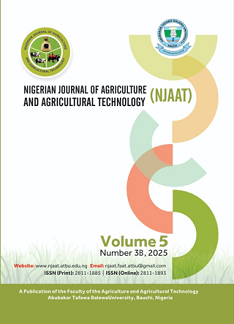COMPARATIVE INFLUENCE OF LIVESTOCK MANURES ON SOIL FERTILITY AND OKRA (Abelmoschus esculentus L. Moench) GROWTH IN CONTROLLED POT CONDITIONS
Keywords:
Nutrient, Organic, Amendments, Soil, Fertility, YieldAbstract
The study assessed the comparative effects of livestock manures on soil fertility and growth performance of okra. The treatments consisted of four livestock manures (cow, goat, pig, and poultry manures) and a control. The experiment was laid out in a completely randomized design (CRD) three replications. Manures were applied uniformly at a rate of 10 tons per hectare. Data were collected on various growth and yield attributes to assess the impact of the manures on plant development. The results indicated significant improvements in soil nutrient levels and okra performance with the use of organic amendments (P<0.05). Poultry manure demonstrated the highest effectiveness among the different treatments applied. This highlights the potential of poultry manure as a valuable addition to enhance both soil quality and crop yields. Poultry manure significantly enhanced nitrogen (0.42%), potassium (2.50 cmol/kg), calcium (22.27 cmol/kg), and magnesium (10.13 cmol/kg) concentrations, as well as soil pH (6.39) better than the other manure used. Okra plants treated with poultry manure produced the tallest plants (57.93 cm), thicker stems (14.39 cm), higher leaf number (17.33), pod number (10.66), and fresh pod weight (38.95 g). These findings demonstrate the efficacy of poultry manure in improving soil fertility and okra yield, highlighting its potential as a sustainable nutrient source in tropical vegetable production systems.
Downloads
Downloads
Published
How to Cite
Issue
Section
License
Copyright (c) 2025 Nigerian Journal of Agriculture and Agricultural Technology

This work is licensed under a Creative Commons Attribution-NonCommercial-ShareAlike 4.0 International License.
This work is licensed under a CC Attribution-NonCommercial-ShareAlike 4.0



